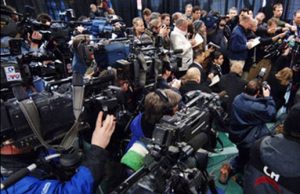
Television holds a special place in broadcast media.
TV stimulates the sound and sight senses so much that it invokes very emotional responses – it really grabs the viewer’s attention, it can really tell a story.
In my blog titled It’s a moving feast, we explored the positive influences and challenges of moving pictures, including online video files.
In addition to these insights, we can add that TV is popular, it’s educational (though emotive story-telling), it’s informative (it can break stories down into easily digestible chunks for the viewer), and it inspires creativity.
Television can also be more cost-effective when using moving images to tell your research story – by getting your story into the evening (or morning) news show.
TV news adds a new dimension – time – to research stories.
TV news items are often shorter, sharper, more directed and more ‘punchy’ than news published in other media. This presents a challenge for telling complex research stories.
Other challenges in using TV news to promote research stories include:
- The first question a TV news journalist will ask when they receive a story is, ‘what and where are the pictures?’ (unless it is blindingly obvious). TV news needs pictures to tell the story when they have the camera available;
- There is greater competition between news makers such as universities and research institutes to get research stories onto State-wide and national news shows and channels;
- Time creates pressure for research stories, as they must fit within shorter time frames and ever-present deadlines. Research story makers must be ready to take or make opportunities for getting research into the news;
- TV news items – with both audio and visuals – are technically more demanding to produce than print or radio news. News makers can assist this production (such as providing a suitable relevant location for interviews or even quality footage of a research subject!) to make the story more enticing to TV journalists and editors. This takes staff time, planning, and financial resources;
- TV channels can be owned by narrow political or interest groups which influence the type of research story that they are willing to accept and cover. This is usually the decision of the news room editor, not the journalist, particularly in regional bureaux.
Researchers can address these challenges by planning and ‘hunting and gathering’ for stories. This might include:
- gathering that fun, quirky smartphone footage of an unusual endangered species can really ‘sell’ your story;
- keeping in contact with a farming family who could provide a wonderful example of your research; or,
- archiving great images of a microscopic bug you have studied for the past three years that could have major implication for agricultural production.
Research news makers can get ready for television news stories by:
- Planning communication activities to consider the resources needed for a good TV story;
- Taking a fully charged smartphone to the field to get those serendipitous photos and video clips for news stories;
- Keeping note of good possible TV interviewees for the research project; and,
- Noting good possible locations for interviews.
In recent blogs, we have discussed a number of possible media for telling research stories. In the next blog, we will consider one way of gathering all these different parts of your story into one place – the website – and how it can be used to better tell your story.
To help you plan your next television news stories, contact The Comms Doctor® via email or visit the Comms Doctor® website.

